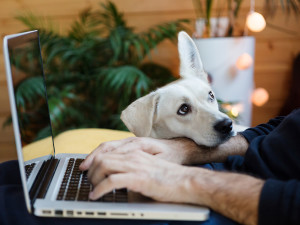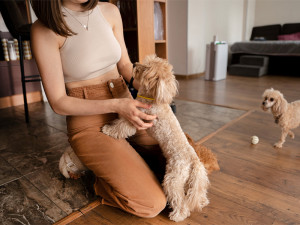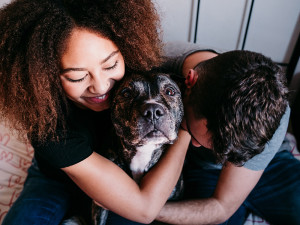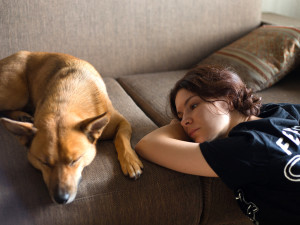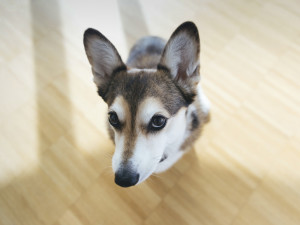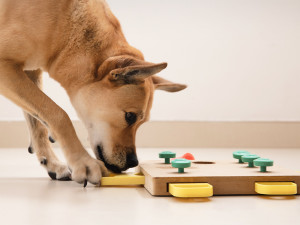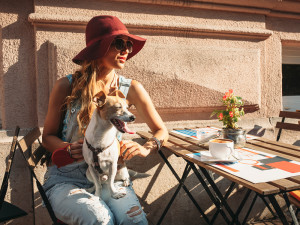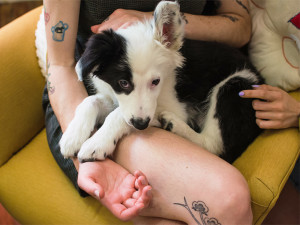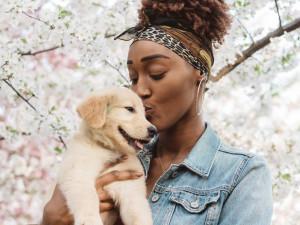How to Help Your Dog Be Just a Little Less Needy
You love that your dog is your shadow, but maybe not when you’re on a Zoom call.
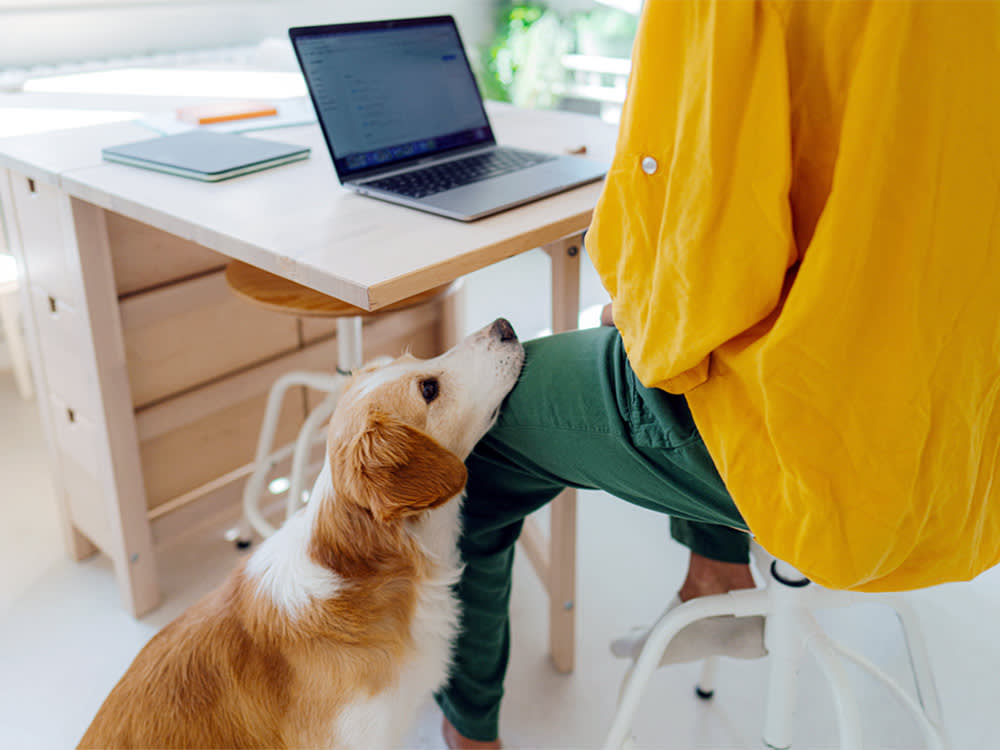
Share Article
As someone who works remotely, I have a serious at-home office setup. It includes a large desk holding multiple monitors with the type of elaborately comfy chair previously reserved for Twitch streamers. The downside to these long-sought-after luxuries is that I rarely use them because my dog can’t get close enough to me when I do. If I don’t sit on the couch, bed, or somewhere else she can curl up next to me all day, she will have a full-on emotional meltdown.
Beyond increasing my back pain by about 5,000 percent, two things have become abundantly clear from this routine. One, I am a very weak man when faced with a sad dog. And two, my pup is way too attached. So, I enlisted the counsel of two experts to help reduce my dog’s clinginess at home.

Get (totally free) deals for food, treats, accessories, tech, and way more pet parenting must-haves.
opens in a new tabWhy some dogs stick to your side
There are copious reasons why your dog may possess Velcro-like qualities. Susan Nilson, animal trainer and founder of The Cat and Dog Houseopens in a new tab, confirms that this behavior is completely normal and, in many cases, just reflects how much they like you (aww).
However, she offers an important caveat: “There is such a thing as being over-attached.” Nilson explains that dogs will often follow their pet parents around simply because they like being near them and are curious about what they’re up to.
These animals could also be anticipating something exciting like being fed or going for a walk. Not to mention, if they follow you around all day, they’re more likely to receive pets or other types of attention, which only leads them to repeat this behavior. So, as difficult as it can feel, it’s imperative to resist rewarding this behavior and other neediness staples, like whiningopens in a new tab.
On a less charming note, your pup might be clinging to you because they’re stressed or scared. As the one who takes care of them, they look to you for protection and reassurance.
“Dogs, like children, tend to use their owners as a secure base, a bit like a security blanket,” Nilson says. Dr. Sabrina Kong, a veterinarian at Jules Veterinary Centeropens in a new tab in Tracy, California, explains that a lack of confidence or recent changes to their environment could be factors, as well.
“Some dogs become clingy if they’re not used to being alone or experienced loss or change, such as moving to a new home or changing the family dynamic,” she says. In short, maybe you should stay together for the kidsopens in a new tab.
Ain’t no sunshine when you’re gone
Of course, if this behavior is consistent every day, there’s likely a larger issue at play. Your pup could be suffering from separation anxiety, a condition I think we all know a little too wellopens in a new tab. Unfortunately, Nilson notes that remedying this situation and managing its symptoms can be a delicate dance. According to the trainer, “separation anxiety needs a carefully structured approach to build up the length of time the dog can manage alone without being stressed.”
Above all, she recommends hiring a professional to help guide you and your dog through the process. But if you’re unable to do so due to time constraints or because you spent all your excess money on pain relief medication for your back, like me, the overarching goal is to help your pup feel safe when they’re alone.
For Nilson, this ideally involves a carefully tailored plan of desensitization and counterconditioning, in which you gradually increase the length of time your dog spends alone while rewarding calm and independent behavior.
But it’s important to remember that dog training is not a Vin Diesel movie and speed should not be the goal. “There is no timeline for this. We simply go at the dog’s pace and need to resist any temptation to rush things along,” she adds.
Short-term solutions
That approach is all fine and dandy, but in the interim, most of us still have things to do, places to go, and backs to have massaged. Thankfully, there are short-term Band-Aid solutions to help limit this behavior in the present so you can still get some work done.
Nilson explains that providing a mentally stimulating toyopens in a new tab is often the best option in these scenarios. Offering your dog something like a snuffle mat or fillable toy will help keep them occupied while you do the dishes, exercise, or work to pay for their special tummy-sensitive dog food.
Nilson specifically suggests a Kongopens in a new tab or LickiMat; they can be filled and frozen overnight to pose a greater and longer-lasting challenge. She explains that these tools are natural stress relieversopens in a new tab that give pups a boost of endorphins. “When dogs are presented with a task where they have to engage their logical, thinking brain, it inhibits the emotional brain, meaning not only will they be happily distracted but also that they will be calmer and more relaxed overall.”
Establishing a scent game is another effective strategy to keep your dog occupied. Plus, Nilson points out that this can be done in a separate room apart from the one you’re trying to be productive in. These games involve scattering or hiding treats and allowing your pup to use their nose to find them.
It might even improve their health, as Nilson explains: “Research shows that sniffing lowers a dog’s pulse rate and blood pressure so this is another easy way to provide a mental challenge which will help keep your dog distracted and calm.”
Other options include offering your dog something with your scent on it to provide additional comfort. Personally, I stopped lending clothes after losing my vintage Get Up Kids t-shirt to an ex, but I can make an exception here. “Dogs feel more secure when surrounded by their familiar scents and this is an easy way to help your dog feel more secure if they’re feeling anxious,” Nilson says. She also mentions dog-specific music or playlists you can find on YouTube or Spotify as effective tools to help further induce calmness.
How to train your dog to be slightly more independent
If your dog was recently adopted or is still a puppy, you may be able to take The Terminator route and stop these issues before they ever develop. Dr. Kong explains that preventing this behavior requires proper socialization and training early on.
“Encouraging independence, rewarding calm behavior, and avoiding reinforcing needy behavior inadvertently are crucial. Ensure your dog has a well-rounded life with plenty of social interactions, physical exercise, and mental stimulation,” she says.
Additionally, an early focus on commands like “stay” or “go to bed” will help teach your pet that being away from you is normal.
I get it — it can be hard to say goodbyeopens in a new tab when you leave, and coming home to a dog losing their mind about your resumed presence is a singularly wonderful experience. But Dr. Kong confirms these habits are not always in your pup’s best interest long-term. “It’s also fundamental to practice leaving and returning home without making a big fuss, which can help minimize anxiety related to your comings and goings,” she says.
The appeal of clingy dogs is clear: Everybody likes to feel needed. But it’s important to remember that it’s in everyone’s best interest if your pet can be a bit more independent. If not for them, do it for the health of your back. Take it from me — yoga classes only go so far.
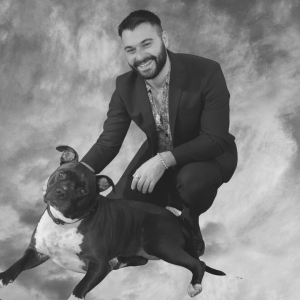
Sean Zucker
Sean Zucker is a writer whose work has been featured in Points In Case, The Daily Drunk, Posty, and WellWell. He has an adopted Pit Bull named Banshee whose work has been featured on the kitchen floor and whose behavioral issues rival his own.
Related articles
![A dog looking up with a cute face]() opens in a new tab
opens in a new tabHow to Get Your Scared Dog to Trust You
Using these tips, your skittish dog will warm up to you.
![Dog looking for treats in an interactive dog puzzle toy]() opens in a new tab
opens in a new tab17 Best Interactive Dog Puzzle Toys
Let the games begin.
![Woman sitting in a cafe with her dog.]()
Can Your Shy New Rescue Dog Become a Social Creature?
With patience and positive reinforcement, you can do a lot to make up for lost time with socialization.
- opens in a new tab
Do Anxious Dog Parents Raise More Anxious Dogs?
Which comes first: a nervous person or a nervous pup?
![woman draped in an orange blanket holds a black-and-white puppy]() opens in a new tab
opens in a new tab5 Development Stages You Should Know When You Get a Puppy
It’s like What to Expect When You’re Expecting, except add “four little paws to run around your house” to the title.
![A woman wearing a knit sweater holding a dog close on the floor of her bedroom.]() opens in a new tab
opens in a new tabSeparation Anxiety in Dogs
Train your dog to stay calm when they’re on their own — instead of sad-singing “All By Myself” until you come home.
